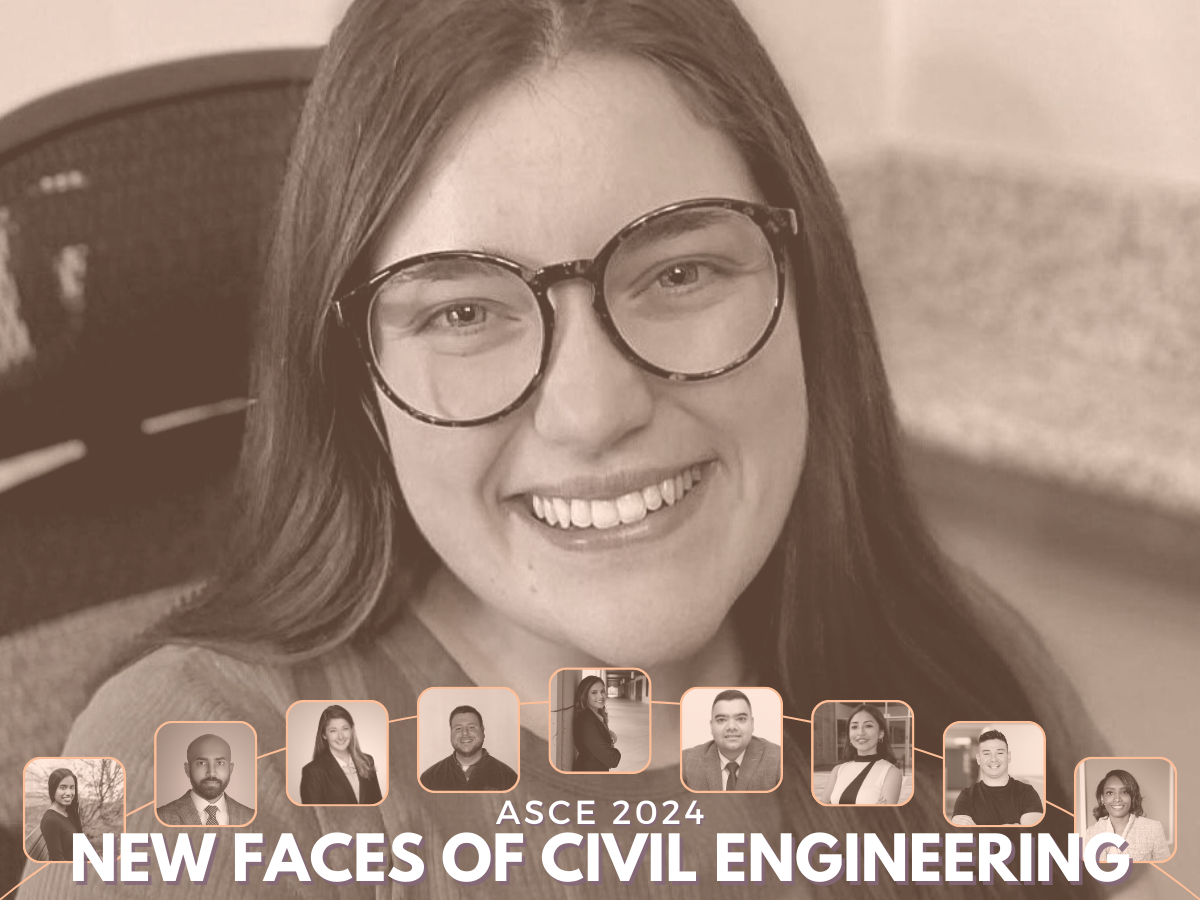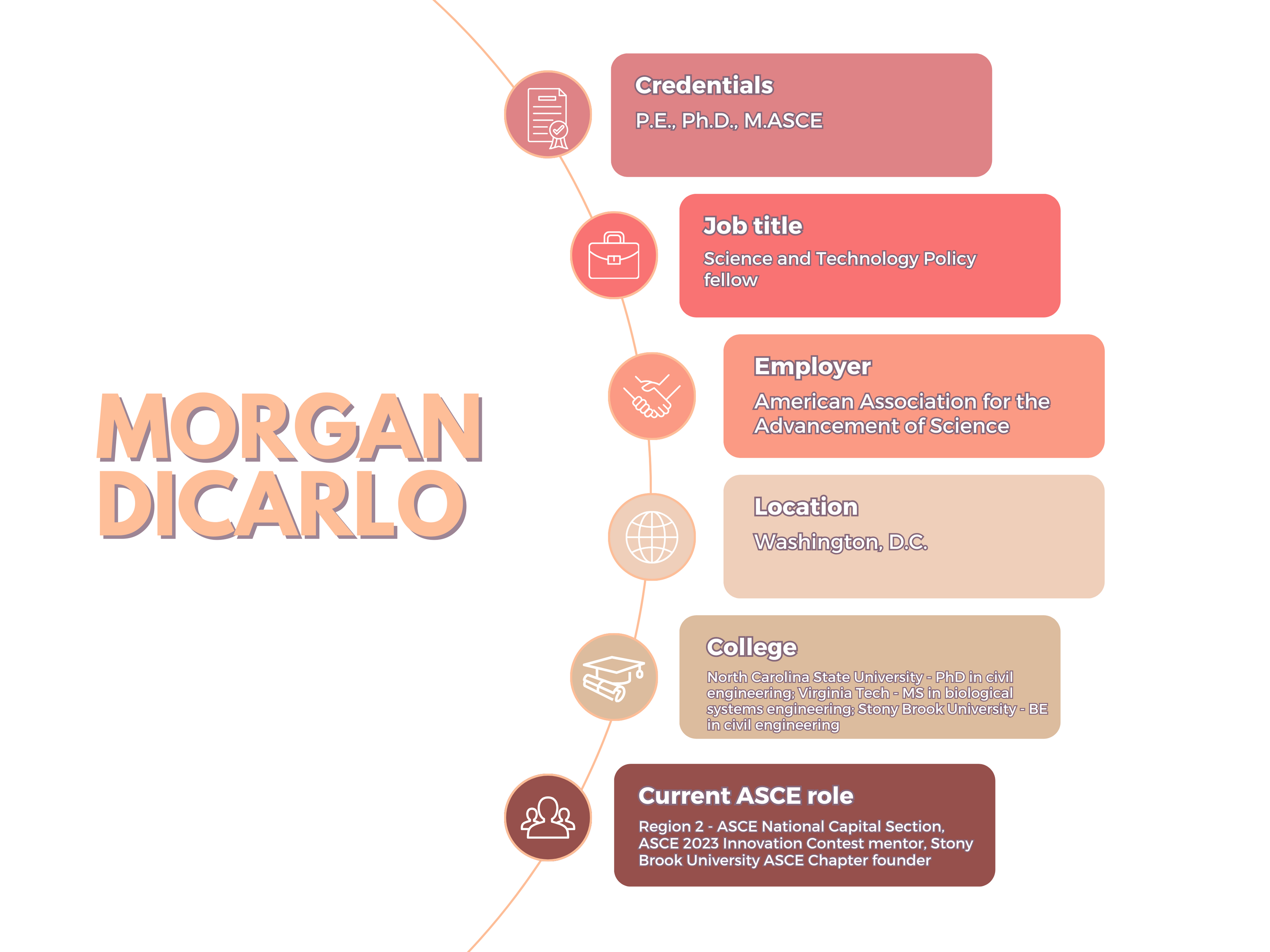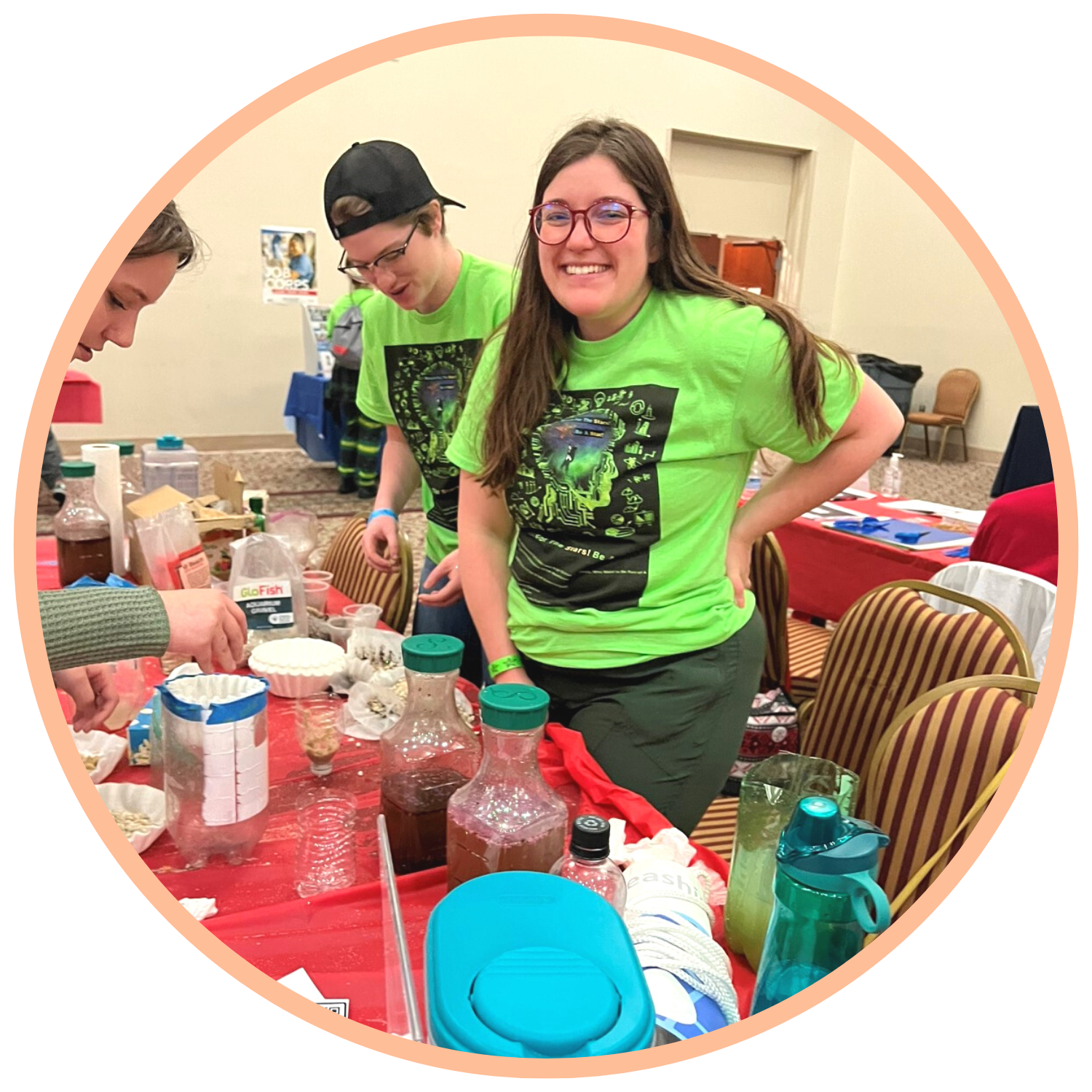

Back in 2016, ASCE went looking for innovations; real gamechangers to help drive down infrastructure life-cycle costs and usher in a new era of sustainability for the built environment.
It was called the ASCE Innovation Contest, and out on Long Island at Stony Brook University, a young undergraduate named Morgan DiCarlo had a big idea.
“It was related to this idea I had about going over your cell phone data usage – which is already kind of a thing of the past [laughs]. But my idea was that you would get alerts on your phone not about your data usage but about your water usage, like, ‘You’re using more than last month,’ or ‘You’re about to get charged more money.’”
DiCarlo won the award for Best Student Innovation that year, and nearly a decade later, the same fascination she had then for incorporating ideas of human behavior into civil engineering innovations have driven her entire career.
DiCarlo now works in Washington, D.C., as a science and technology policy fellow for the American Association for the Advancement of Science, having earned a master’s in biological systems engineering at Virginia Tech and her Ph.D. in civil engineering at North Carolina State.
“I hooked into those ideas and just kept trying to go after it. It’s 100% my research question,” DiCarlo said.
“Then when I was looking for a Ph.D. program, I thought ‘I want to take this further.’ I wound up at North Carolina State University with Dr. Emily Berglund, my advisor. She’s focused on social and technical systems through this tool called agent-based modeling.
“As part of my research, I was building these agent-based models where you give people, in a virtual space, decision-making tasks and you can see how they respond over time and to their environment.
“So it’s kind of fun, because it did start with this ASCE Innovation Contest idea, and I’ve been around those questions for a long time now. These are the things I like to think about.
ASCE has honored DiCarlo as a 2024 New Face of Civil Engineering.
She recently spoke to Civil Engineering Source about her career.

Civil Engineering Source: What is the accomplishment or aspect of your career so far that you’re most proud of?
Morgan DiCarlo: That’s easy. It’s finishing my Ph.D. last year. I learned so much and I would encourage other people to try graduate school. I was very intimidated going into the process and then wound up having a good time.
One of the reasons I got to grow so much is because much of it overlapped with COVID. There were so many pivot points along the critical path of what my advisor and I had intended to research that had to be switched out because we couldn’t do work in person. It was a process of adapting, but I kept thinking, “It’s going to get done, and it’s going to get done on time.”
That made me learn a lot about myself, and it taught me new things. We pivoted from this international-intended scope to working with really local partners. That taught me a lot about how water utilities right where I was in North Carolina operate. And that’s kind of been the gift that keeps giving.
I started using a lot of computational tools, and I think I’m lucky that I wound up with those skills versus maybe what I would have done alternatively.
So I’m really proud of myself for the Ph.D. There were a lot of hiccups during COVID that we adapted to and succeeded anyway.
Source: When you started as an undergrad, did you always intend to eventually pursue the Ph.D. track?
DiCarlo: I definitely did not know. My class at Stony Brook University was the first year that they had a civil engineering major. So we didn’t have alumni to guide us. I founded their ASCE Student Chapter as a way to get local engineers and professionals to get interested in us and, basically, give us jobs.
So I was very industry-oriented for most of undergrad, trying to make these professional connections for myself and the other people in the class. It wound up being a big opportunity, because we got to meet a lot of engineers who were very excited about having a civil engineering university presence on Long Island. I started the chapter motivated by really wanting a job straight out of undergrad.
But over the course of undergrad, I did get the idea for graduate school in my head. I was getting more and more interested in water and environmental questions. And with Stony Brook being new, we didn’t have an environmental engineering program specifically. My faculty there thought it’d be great if I did at least a master’s degree to round out some of the water and environmental content that I might not have gotten at Stony Brook.
I wound up at Virginia Tech, and I liked the research there. Then I got a National Science Foundation grant to keep moving with my research, and I took that grant with me at North Carolina State.
So it was really me first being curious to learn more, then liking research and finding it challenging and interesting, and getting a really good opportunity to get funded to do so. That took me all the way through, and I wound up going straight undergrad through Ph.D. I didn’t work in between at all.
There were big jumps, and it kept surprising me. I didn’t know what was next as it was happening.
Source: What impact are you hoping to make on the profession?
DiCarlo: I finished my Ph.D. and I did one year in industry as a contractor. Then this American Association for the Advancement of Science fellowship came up as an opportunity.
It was on my radar, and I got placed with the EPA, which I was so excited about because their whole mission is about protecting human health and the environment, which aligns well with everything I went to school for.
What I’d really like to contribute to the profession is an advanced understanding of more science around things that traditional civil engineering design approaches and our empirical equations don’t really account for at present.
So I’m hosted by EPA’s Integrated Climate Sciences Division. I think that’s one area that I hope to contribute back into the profession of civil engineering – a readiness to create designs and retrofit designs to be ready for the effects that climate change will have on our built infrastructure and on people’s well-being and livelihoods.
Climate change really is changing the way coastal communities look. It’s changing the way inland communities look, too. There are different modes of natural disasters, and people are going to react and adapt to those disasters in various ways that right now very traditional design methods aren’t fully accounting for. And we need more information about that.
That’s one area of a deep dive within my research, to hopefully inform the profession about about the effects of people’s behaviors.
The best laid plans of mice and men often go awry, right? Engineers can design and build anything that they want, but it’s really subject to human behavior and how people will react both when that infrastructure is threatened by climate and with their own everyday interactions and responses.
So, with my Ph.D. focusing on human behavior and water-related hazards, and now my work in a climate science position, that’s just beginning. I think that I can contribute to civil engineering more understanding on climate readiness and how human behavior affects our designs.
Source: Some people research and some people communicate, but you seem to be someone who excels at both. You’ve done a TED Talk. Is that something that comes naturally to you, and why is that something you prioritize?
DiCarlo: I hope it’s a skill I have. I’ve always been a people person. I like to put myself out there – including going after grants. I think it obviously helps fund your research, but it also helps you go to conferences. It helps you meet more people and gives you a platform.
Where it originally came from – and you mentioned the TED Talk – was Stony Brook. The civil engineering program has grown exponentially, but it started off at the very beginning with us in mechanical engineering classes just taking the core credits before we diversified into civil.
And I was shocked – I don’t know, maybe I shouldn’t have been – but in some of those courses there’d be three or four female presenting students and hundreds of guys.
And I thought, “This is not going to work.” Like there were times where I was actively uncomfortable. For the first time ever, I was intimidated about raising my hand. It felt like a weird place for me to wind up. So I thought, “I don’t like this at all. How can we get more girls to enroll in engineering right away, like by next year?”
And that was my motivation for starting a curriculum with Stony Brook’s Women in Science and Engineering program for high school juniors and seniors to come to campus and learn about civil engineering. And we started that program my first summer at Stony Brook, and that was the subject of my TED talk.
It’s been adapted in several ways. It’s this small, five-session curriculum to show students some hands-on engineering skills, and it can be scaled up or down.
Since then, I have worked with the Intrepid Museum in New York City on some of their summer programs and was on their STEM Advisory Board. It’s just so rewarding.
I’m trying to get involved in Washington, D.C., now. I recently started volunteering with Smithsonian for their design challenges. So it’s third- through sixth-graders coming in and building rockets with us at the museum.
Everywhere I go, it’s like the first thing I try to get involved in. Working with the students is always fun, and it always makes me think about things differently – which is important. When you’re an engineer you can’t just do the same things all the time. You’ve got to be innovative.
Overall, I think for me it’s pretty natural to communicate and connect. But it’s only natural because I really feel like a call to do it. It’s an obligation. It comes from how confused I felt right at the beginning when I was outnumbered – I’ll put it that way. And I think there’s a lot of people who don’t feel very strongly represented in science and technology careers.
There is a real call for friendly faces, intentional ways to include people. I think our profession desperately needs it. We’re not going to thrive and we’re not going to make strong designs if we don’t include the perspectives of the diverse groups of people that have to work, live, and learn in those designs.
There is so much history where engineers and designers have missed the mark, and some communities don’t have the same quality of infrastructure and life that other communities do. I think more people need to be at the table for us to arrive at a better design. It sounds a little idealistic, but I mean that.
So, outreach is natural to me because I feel it’s the only option..
It’s really important. I care about it.



